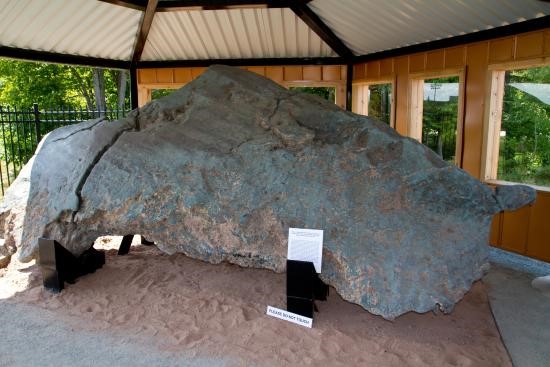I thought I’d step away from the markets today and share a story from a trip I did while in the States last month.
It focuses on some historic copper mines along the Keweenaw Peninsula in the north-eastern state of Michigan.
These mines once contained the largest concentration of pure copper (also known as native or elemental copper) on Earth.
Here’s a picture of a 17-tonne pure copper boulder sitting at the front of a museum in the Upper Peninsula area of Michigan…
|
|
| Source: James Cooper |
So, what’s the big deal with pure copper?
Well, the metal is almost always found in sulfide ores. These are minerals harbouring many elements, copper being just a tiny fraction of the overall volume.
Some of these ores are so brilliantly coloured they resemble the multicoloured hues of peacock feathers…such as bornite, one of the highest grade copper ores available to miners.
To extract the copper, the ore is run through giant crushers to grind down the rock…
From there, the material is run through a processing plant that involves several steps including floatation, which liberates the copper from the waste sediments.
Of course, the miners in Michigan didn’t need to do any of this. Pure copper boulders the size of trucks were as good as money in the bank.
But this geological freak of nature holds some interesting mysteries…
The area is littered with ancient copper mines.
Incredibly, archaeologists have dated some of these mines as old as 5,000 years.
It’s why the ancient copper mines of Michigan have sparked decades of conspiracy theories…
Who mined the copper? Where did they come from and why did they leave their operations as if they were expected to return the next day — but didn’t?
It’s a deep mystery that puzzles historians and archaeologists.
These weren’t small scale operations either…
Sources estimate that around one billion pounds of copper was mined by these ancient miners.
That’s an enormous volume of metal even by today’s standards.
But the peculiar thing is, archaeologists have found very little evidence of this copper among the indigenous populations of North America.
So here comes the first conspiracy…
Some speculate that the ancient miners arrived from faraway lands.
Radiometric dating estimates the age of the mines from around 3,000 to 1,500 BC…a period in ancient history that overlaps with the Bronze Age in Europe.
Historians have long been puzzled by the vast quantity of copper that ‘turned up’ in Europe over this period.
History has already been turned on its head after evidence was found indicating the Norse people (modern day Greenland) established settlements in North America as far back as 985 AD.
That was nearly 500 years before the birth of Christopher Columbus…the established norm for first European arrival on North American soil.
But answered questions stemming from these ancient copper mines have caused many to speculate that Europeans arrived far earlier still.
Another mystery is how these ancient people uncovered the deep geological treasures.
Many of the ancient mines tracked veins from surface…similar to how the old miners from the 18th and 19th centuries located and mined gold veins.
Except, some of the extracted copper seams had no visible evidence of mineralisation at surface.
Today we use geochemistry to find anomalies in the soil or send electrical impulses through the ground using geophysics to find deep sub-surface deposits.
Both strategies are technical and have only been in use in modern times.
Was there some advance tool that enabled these ancient miners to detect copper deposits well below the surface?
Again, no one knows but it adds to the intrigue of these ancient mines.
As I touched on earlier, these same mines were reworked centuries later, from 1845 up until 1887.
In fact, the region provided most of the country’s copper needs during its early settlement years.
That includes the US Civil War where demand for copper caused prices to rocket three-fold from pre-war prices.
We have our own copper history in Australia too…
While not ancient, the Mt Isa region of Queensland and South Australia’s Cornish mining districts helped establish the early economy of these two states.
With copper set to re-ignite in the years ahead, explorers could be turning a new page on these old copper mines.
In fact, exploration geologist often target historic diggings…either below or adjacent to the old workings.
Improvements in technology allow geologists to uncover more treasure around these mines…rich ore that was missed by the old timers.
It means right now could be a great time to stake your claim on an old copper mine!
Until next time,
 |
James Cooper,
Editor, Fat Tail Commodities



Comments